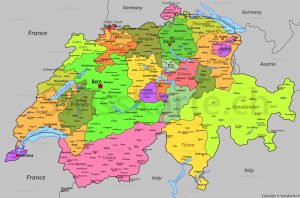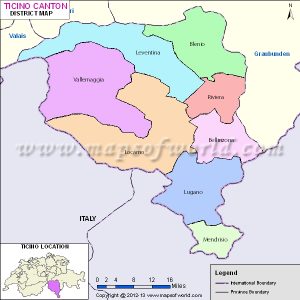The Castles of Bellinzona
are a group of fortifications located around the town of Bellinzona, the capital of the Swiss canton of Ticino. Situated on the Alpine foothills, the group is composed of fortified walls and three castles named Castelgrande, Montebello, and Sasso Corbaro. Castelgrande is located on a rocky peak overlooking the valley, with a series of walls that protect the old city and connect to Montebello. Sasso Corbaro, the highest of the three castles, is located on isolated rocky promontory south-east of the other two.[1] The Castles of Bellinzona with their defensive walls have been a UNESCO World Heritage Site since 2000.
Pre-History and Roman era. Bellinzona 
has always occupied an important geographic location in the Alps. To the south, the Po valley is accessible by a lowland route down the valley of the Ticino river and by Lake Maggiore. … The town that grew up around the fortifications was known as Bilitio.
The fight over the Region
Under the control of the Visconti, trade flourished and the city of Bellinzona grew. Even when an alternative route over the Alps, the Schöllenen bridge opened, traffic in the St. Gotthard increased to the highest levels ever.[7] During the second half of the 14th century a long wall, known as the Murata, was built across the entire valley of the Ticino, of which the bottom is about one kilometer wide at Bellinzona. This wall allowed Milan to protect and tax the trade route over the St. Gotthard Pass.[4] While the city was controlled by Milan through the Visconti after 1340, the Visconti did not have a formal title and feudal rights until 1396 when they were granted by King Wenceslaus. However, the orderly growth of Bellinzona was threatened in 1402 when Duke Gian Galeazzo Visconti died. In 1403 Bellinzona was taken under the control of Alberto di Sacco of Val Mesolcina. He held Bellinzona until 1419 when it was taken over by Uri and Obwalden which had expanded into the Leventina Valley. Milan attacked the city three years later in 1422 after an offer to buy the city was rejected by the Swiss Confederation. The troops from Uri and Obwalden were quickly driven from the city and later defeated at the Battle of Arbedo on June 30, 1422. This defeat discouraged the expansionist intentions of Uri and its allies towards Lake Maggiore for a time.
My visit to Castelgrande
revealed a beautiful restaurant within the walls of the castle, niched away in, what seemed like a wine cellar, was the restaurant which was connected to a larger restaurant towards the courtyard of the castle, during the summer guests can enjoy food and beverages sitting in the open courtyard of the castle. The views over the entire Po valley are breathtaking.
 Highlights
Highlights
• Three castles – the medieval fortifications, with the castles of Castelgrande, Castello di Montebello and Castello di Sasso Corbaro, are a UNESCO World Heritage Site.
° Villa Dei Cedri – a municipal art gallery with Swiss and Italian paintings from the late 19th and early 20th century, as well as contemporary art. There is a particular focus on artists from the local area.
- Old Town – in the area around the Piazza Nosetto, Via del Teatro, and Piazza del Governo, the Old Town boasts a wealth of beautiful merchants’ houses, stone gateways, balconies with wrought iron railings, and inn signs from a bygone era.
- Teatro Sociale – inspired by La Scala in Milan, the building is in the typically Italian Classical style and is the only theatre in Switzerland to have been preserved from the 19th century.
- Modern architecture in Bellinzona – in the Castelgrande, the architect Aurelio Galfetti has cleverly integrated a boldly designed restaurant, while the Convento delle Agostiniane on the Monte Carasso has been converted into a modern training center by the architect Luigi Suozzi.
When you visit Switzerland or the North of Italy I recommend you put this site on your bucket list.
https://en.wikipedia.org/wiki/Castles_of_Bellinzona
https://www.myswitzerland.com/en-ch/bellinzona.html

 Highlights
Highlights